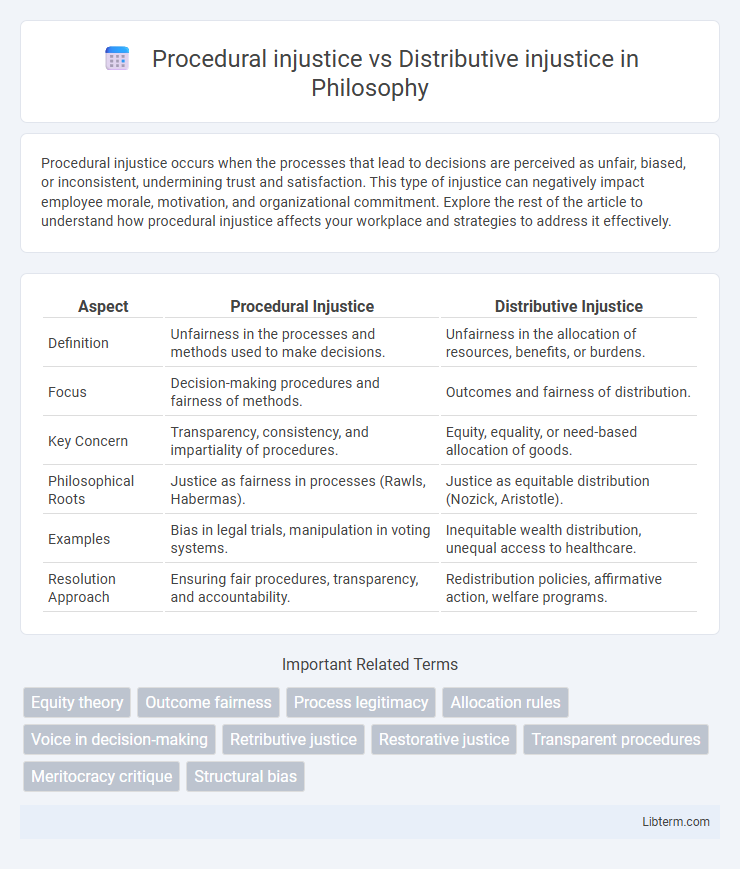Procedural injustice occurs when the processes that lead to decisions are perceived as unfair, biased, or inconsistent, undermining trust and satisfaction. This type of injustice can negatively impact employee morale, motivation, and organizational commitment. Explore the rest of the article to understand how procedural injustice affects your workplace and strategies to address it effectively.
Table of Comparison
| Aspect | Procedural Injustice | Distributive Injustice |
|---|---|---|
| Definition | Unfairness in the processes and methods used to make decisions. | Unfairness in the allocation of resources, benefits, or burdens. |
| Focus | Decision-making procedures and fairness of methods. | Outcomes and fairness of distribution. |
| Key Concern | Transparency, consistency, and impartiality of procedures. | Equity, equality, or need-based allocation of goods. |
| Philosophical Roots | Justice as fairness in processes (Rawls, Habermas). | Justice as equitable distribution (Nozick, Aristotle). |
| Examples | Bias in legal trials, manipulation in voting systems. | Inequitable wealth distribution, unequal access to healthcare. |
| Resolution Approach | Ensuring fair procedures, transparency, and accountability. | Redistribution policies, affirmative action, welfare programs. |
Understanding Justice: Procedural vs Distributive
Procedural injustice occurs when the processes or methods used to make decisions are perceived as unfair, undermining trust in legal or organizational systems. Distributive injustice refers to the perceived unfairness in the allocation of resources, benefits, or burdens among individuals or groups, often measured by equity, equality, or need-based criteria. Understanding justice requires distinguishing how procedural fairness influences acceptance of outcomes, while distributive fairness pertains directly to the outcomes themselves.
Defining Procedural Injustice
Procedural injustice occurs when the processes and methods used to make decisions are perceived as unfair, lacking transparency, consistency, or impartiality, leading to distrust and dissatisfaction among affected parties. It contrasts with distributive injustice, which centers on the equitable allocation of resources or outcomes, irrespective of the fairness of the procedures. Examining procedural injustice highlights the importance of fair decision-making practices in organizational justice and conflict resolution.
What Constitutes Distributive Injustice?
Distributive injustice occurs when resources, benefits, or burdens are allocated unfairly across individuals or groups, often leading to inequality and social dissatisfaction. It involves biased or unequal distribution criteria that fail to meet standards of equity, need, or contribution, resulting in perceptions of unfair treatment. Key factors constituting distributive injustice include lack of proportionality, favoritism, and neglect of legitimate claims, which undermine trust and social cohesion.
Key Differences Between Procedural and Distributive Injustice
Procedural injustice occurs when the processes or methods used to make decisions are perceived as unfair, lacking transparency, consistency, or impartiality. Distributive injustice refers to the perceived unfairness in the allocation or distribution of resources, benefits, or burdens among individuals or groups. The key differences lie in procedural injustice focusing on the fairness of decision-making mechanisms, while distributive injustice emphasizes the equity of outcome distributions.
Real-World Examples of Procedural Injustice
Procedural injustice occurs when fair processes are not followed, such as biased court rulings or opaque hiring practices, leading to mistrust in institutions despite equitable outcomes. In contrast, distributive injustice involves unfair allocation of resources or benefits, like unequal pay for equal work or disparities in healthcare access. Real-world examples of procedural injustice include police departments using discriminatory stop-and-frisk policies and companies implementing opaque promotion criteria that systematically disadvantage minority employees.
Real-World Examples of Distributive Injustice
Distributive injustice occurs when resources, wealth, or opportunities are allocated unevenly across different social groups, leading to significant inequality. Real-world examples include wage disparities between genders and racial groups, unequal access to quality healthcare, and disproportionate educational funding based on neighborhood demographics. These disparities highlight the tangible consequences of distributive injustice on social mobility and economic stability.
Impact of Procedural Injustice on Society
Procedural injustice undermines trust in institutions by creating perceptions of unfair treatment in processes such as legal adjudications, organizational decisions, and governance. This erosion of perceived fairness leads to decreased social cooperation, increased conflict, and diminished civic engagement, which harm social cohesion and stability. Unlike distributive injustice that focuses on unequal outcomes, procedural injustice disrupts societal harmony by questioning the legitimacy of systems that govern resource allocation and rights enforcement.
Societal Consequences of Distributive Injustice
Distributive injustice, characterized by unequal allocation of resources, often leads to deep social stratification and heightened economic disparities within communities. This inequity fosters social unrest, erodes trust in institutions, and contributes to systemic marginalization of disadvantaged groups. Long-term societal consequences include increased poverty rates, reduced social mobility, and weakened social cohesion.
Strategies for Addressing Procedural Injustice
Strategies for addressing procedural injustice involve enhancing transparency, ensuring impartial decision-making, and promoting inclusive participation in processes. Implementing clear, consistent rules and providing avenues for appeals or grievances increase perceptions of fairness and trust. Training decision-makers on fairness principles and actively involving affected parties contribute to more equitable outcomes and reduced conflict.
Solutions to Tackle Distributive Injustice
Solutions to tackle distributive injustice emphasize equitable allocation of resources, ensuring fairness in economic opportunities, and implementing progressive taxation policies to reduce income disparities. Developing transparent criteria for resource distribution and promoting social safety nets can address systemic inequalities affecting marginalized communities. Incorporating community participation in decision-making enhances accountability and aligns resource allocation with the needs of underprivileged groups.
Procedural injustice Infographic

 libterm.com
libterm.com